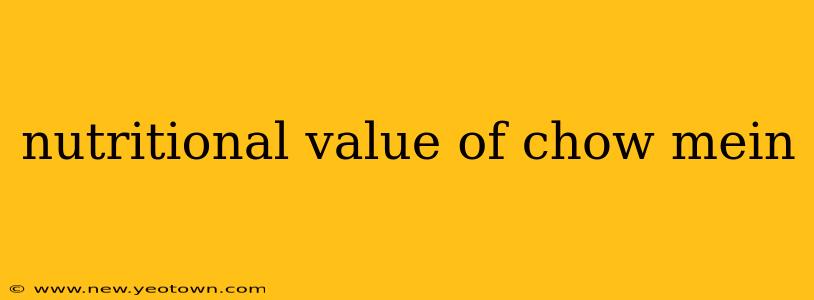Chow mein, the beloved stir-fried noodle dish, is a staple in many cuisines across the globe. But beyond its delicious taste and satisfying texture, what's the real nutritional story behind this popular comfort food? Let's embark on a culinary journey to uncover the nutritional value of chow mein, exploring its potential benefits and drawbacks. This isn't just about calories; it's about understanding how different ingredients can significantly alter the overall nutritional profile.
What are the main ingredients in Chow Mein?
The beauty (and sometimes the beast) of chow mein lies in its versatility. The foundational ingredients usually include noodles (typically egg noodles or wheat noodles), a protein source (chicken, pork, beef, shrimp, tofu, or even vegetables alone!), and a medley of vegetables like broccoli, carrots, cabbage, and onions. The sauce, a crucial component, is where things get interesting, often a blend of soy sauce, oyster sauce, and other seasonings. The specific nutritional content will depend heavily on these ingredient choices.
How many calories are in a serving of Chow Mein?
This is a tough question to answer definitively! A single serving of chow mein can range dramatically from around 300 calories to well over 1000, depending on portion size, noodle type, protein choice, and the amount of oil and sauce used. A lighter version, packed with vegetables and lean protein, will naturally be lower in calories than a rich, saucy dish with copious amounts of meat and oil.
Is Chow Mein healthy?
The healthiness of chow mein is not a simple yes or no. It's a spectrum. A thoughtfully prepared chow mein can be a surprisingly nutritious meal. The vegetables contribute essential vitamins, minerals, and fiber. Lean protein sources support muscle growth and satiety. However, a heavily oiled, sodium-rich, and meat-laden version can be quite detrimental to your health. The key is mindful preparation and ingredient selection.
What are the benefits of eating Chow Mein?
- Vegetable Powerhouse: A well-made chow mein offers a significant portion of your daily vegetable intake. These vegetables provide crucial vitamins (like vitamin A, vitamin C, and vitamin K) and minerals (like potassium and iron).
- Protein Source: The protein in chow mein contributes to building and repairing tissues, supporting a healthy metabolism, and keeping you feeling full. Opting for lean protein sources like chicken breast, tofu, or shrimp minimizes saturated fat intake.
- Fiber Boost: The vegetables and noodles provide fiber, aiding digestion, promoting gut health, and helping to regulate blood sugar levels.
What are the drawbacks of eating Chow Mein?
- High Sodium Content: Soy sauce, a staple in many chow mein recipes, is notoriously high in sodium. Excessive sodium intake can contribute to high blood pressure and other health problems.
- Hidden Fats and Oils: The cooking process often involves a significant amount of oil, leading to a higher calorie and fat content, especially if deep-fried.
- Refined Carbohydrates: While noodles offer some energy, they're primarily refined carbohydrates, which can cause blood sugar spikes if consumed in large quantities.
How can I make healthier Chow Mein?
Making healthier chow mein is entirely possible! Consider these tips:
- Choose whole-wheat noodles: These provide more fiber than traditional egg noodles.
- Load up on veggies: The more vegetables, the better!
- Opt for lean protein: Chicken breast, tofu, or shrimp are excellent choices.
- Reduce the oil: Use a minimal amount of oil for stir-frying, and consider healthier alternatives like avocado oil.
- Watch the sodium: Use low-sodium soy sauce or tamari, and be mindful of other salty ingredients.
- Portion control: Be aware of serving sizes to manage calorie intake.
Chow mein, when prepared thoughtfully, can be a delicious and relatively healthy part of a balanced diet. By being mindful of your ingredients and cooking methods, you can enjoy this culinary classic without compromising your health goals.

